SEO is not dead, not even in 2020. Yes, the keyword optimizing has changed a lot from the last decade but still, you can utilize SEO to outrank your competitors.
And one of the most crucial parts of SEO is keyword optimization. Before I show you the exact ways of doing proper keyword optimization for your target keyword, there is one myth that you need to understand.
You may have heard of people saying about keyword optimization a lot. But the mistake that most of the newbie or even intermediates make is that they only focus on optimizing keywords.
Days are gone when you just add the related keywords or LSI keywords into your blog post and your articles start ranking on the first page.
Even the recent update of Google also clarify that article with in-depth content around a topic is more likely to get an advantage than the article which is not in-depth.
In fact, the article with in-depth information is the new way of outranking your competitors.
Here is the look of the official update from Google.

Click here to read more about the update for in-depth articles on Google.
Pro Tip: Instead of focusing on a specific target keyword, focus on a very specific and relevant topic for your blog post.
So, let’s have a look at the right way of optimizing your article for a specific topic, instead of any specific keyword.
Because that way your article will be more in-depth and help the readers to understand every aspect of the topic as well.
Tools I will use in this article to show you the process of optimizing your content are:
For your better understanding, I m considering a target keyword and will show you how to find relevant keywords for that target keyword and how to structure your article as well.
In order to understand this ultimate guide on keyword optimization, we’ll assume a few things which are:
Let’s say your niche is content writing and you found a keyword that you think has a good chance for ranking on the first page of Google.
I am assuming that the keyword is ”How to become a content writer”.
So, here you’ll learn how to write your article by properly optimizing keywords around the target keyword.
You can also easily relate your own keyword. Just follow the methods and tips which I am going to share with you.
Step 1: Create Google Sheet
The first thing You need to do is make a google sheet where you’ll list down all of the possible and relevant keywords that you must include in your article.
Follow this Link Google Sheet for keywords list
After making a new sheet, create 7 columns, and name them as shown below.
Here’s what it looks like.
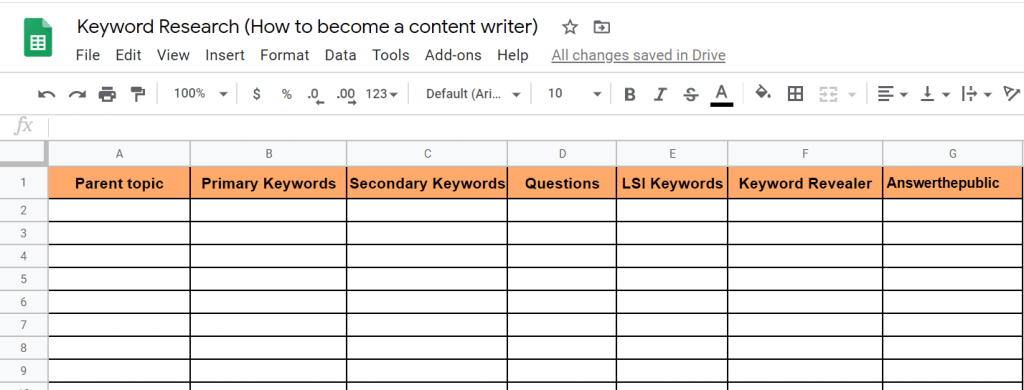
- Parent topic
- Primary keywords
- Secondary keywords
- Questions
- LSI Keywords
- Keyword Revealer(Optional)
- Answerthepublic
I have created 7 columns for categorizing 7 different types of keywords.
Don’t worry, I will discuss every type of keywords.
What I can promise you is that after following this ultimate guide you don’t need to think anymore about what keywords to add in a specific article.
Okay, let’s move forward and start digging keywords for your target keyword.
Step 2: Parent topic and primary keywords
Go to your Ahrefs account and click on the keyword explorer button.

Now, you need to type your target keyword for which you want to rank on the first page.
[In your case, just type your own target keyword]
This is what the result looks like:
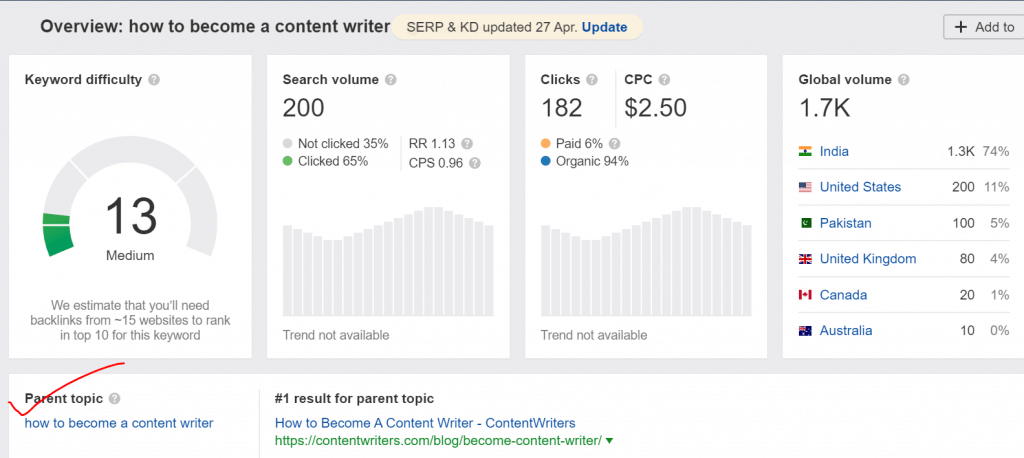
Okay, observe that just below the keyword difficulty section, there is a section called the parent topic.
This is what you need to focus on.
In my case, the target keyword and the parent keyword both are the same. In your case, it might be different.
Whatever it is, just copy the keyword in the parent keyword and put it in the google sheet.

Again, In my case parent topic = Primary Keyword
Primary keyword → Your target Keyword
Parent topic → Keyword you get from Ahrefs
Step 3: Secondary keywords
Till now we had just discovered the basic or base of your whole keyword list. Let’s understand how to determine the secondary keywords.
Now just scroll a little bit on the Ahrefs page from where you just got the parent keyword. Go to the “Also Rank for” section.
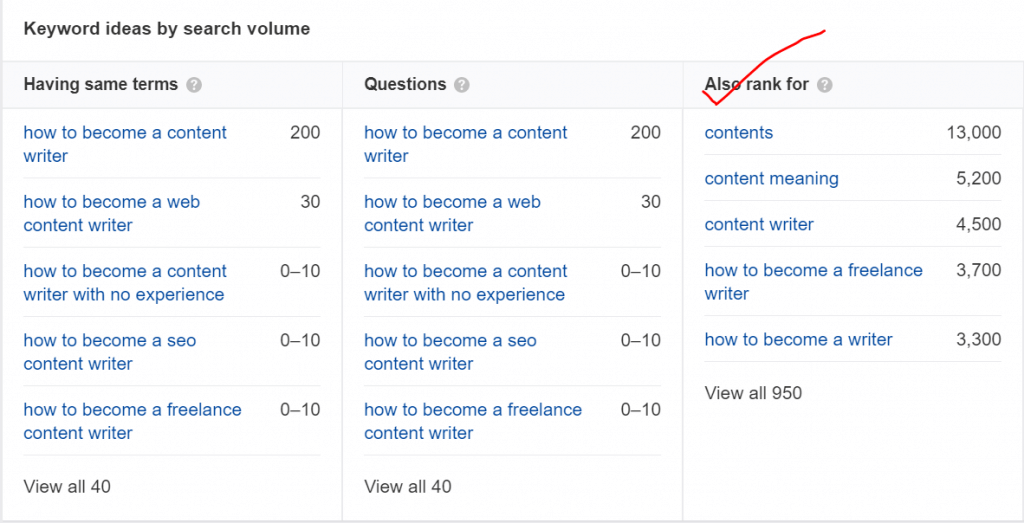
These are the keywords that are highly related to your target keyword. This will help you to cover most of the keywords that possibly align with the search intent of your target keyword.
After clicking on the section, you will be redirected to the page where you can see lots of one word, two words, or even more words keyword.
[Note: you don’t need to choose all of these keywords. Just consider the most relevant ones.]
How to know whether it is a relevant keyword for me?
Just consider yourself as your reader and try to understand what type of questions you want to know.
For example, anyone who wants to become a content writer might want to work as a freelancer or want to get a high paid job as well.
So just go over the keyword list and choose the keywords that only match the primary keyword in terms of relevancy and search intent.
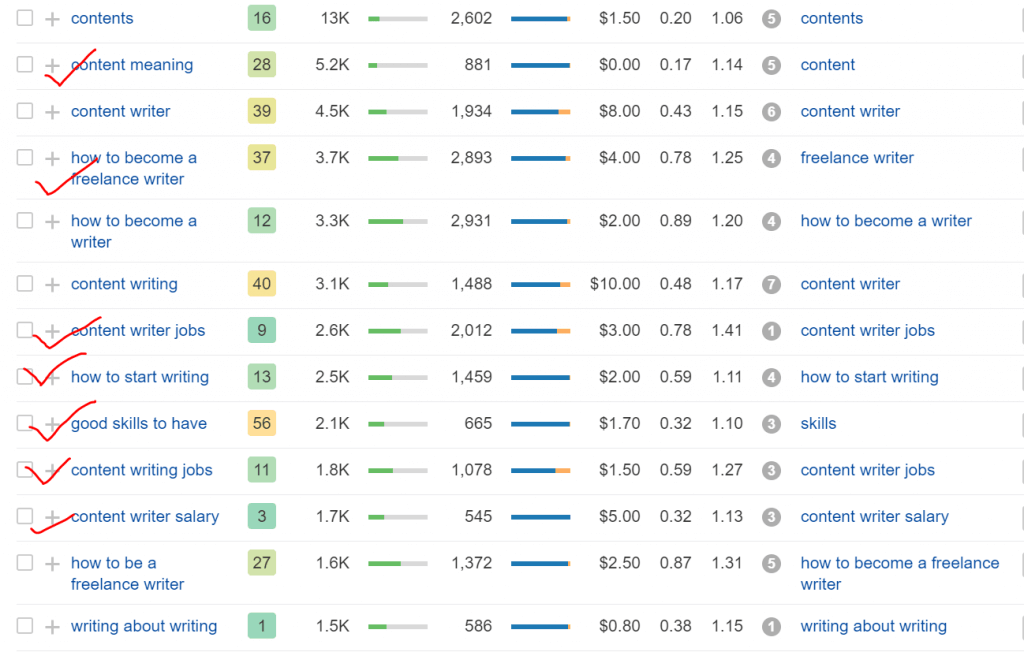
Okay, in this case, I have considered some keywords. And the next step is to put all of these keywords on the google sheet.
This is how it is looking right now.

With every step, all of the columns are going to get filled with rich keywords that are relevant and must have to make your content better.
Step 4: Questions
Now, this is one of the most crucial parts of this ultimate guide, because here you’ll get the keywords that your audience are actually asking.
So that means if your content answer these questions, it will become a high-quality content because you’re solving someone’s query and questions as well.
Let’s see how to perform this step.
On the same page, you’ll also get to see the section for ‘questions’.

By clicking the Questions’, you’ll get a bunch of questions related to your target keyword.
Make sure you try to cover these questions as much as possible. It is better to cover the keywords that match the search intent and relevancy of your primary keyword.
[Pro Tip: Try to use these questions as sub-headings in your article].
Now, add these questions in your google sheet as well.
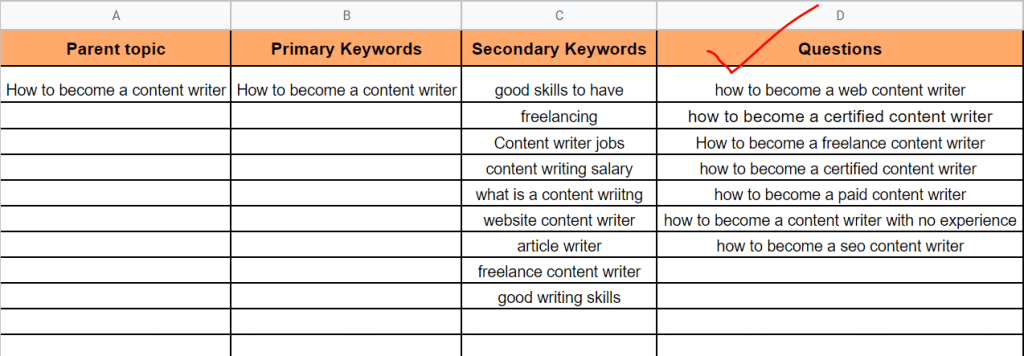
[In step 6, I will show you how to get keywords from the online tool, answerthepublic.com]
Step 5: LSI keywords
You might have heard of LSI keywords. In fact, LSI keywords are a great way of helping Google to understand what your article is all about.
Let’s dive deep into some highly relevant LSI keywords.
In the case of LSI keywords, you have multiple options. I will show you each of these methods to get the LSI keywords for your topic.
Let’s go one by one.
Option 1: Google suggestions
This is one of the old yet powerful techniques to understand the search queries.
Go to Google.
First, type your primary keywords in the search box.
In this case, it is “How to become a content writer”.

Next, scroll down to the bottom of the page and you’ll see lots of keywords which you might have ignored for a long time.
But these are the keywords that possibly match the search term in terms of search intent and relevancy.

Option 2: LSI graphs
LSI graph is an amazing tool for getting lots of super valuable LSI keywords. Though the free version of LSI keywords comes with some, limitation this will help in many ways.
Here it is.
Search on Google with the term “LSI graphs”. And click on the first link.

Now, just type your primary keyword on the search box and wait for the results.

Chances are most of the keywords you’ve already covered with the help of Ahrefs.
This process is just to make sure that you collect all of the possible LSI keywords so that your content becomes irresistible as compared to others.

Here, you can get a lot of keywords. Yes, you won’t get the full list as you’re using the free plan. But this is also a good way to add some high-quality keywords in your list as well.
So add those keywords which match your primary keywords.
Let me show you what are the keywords that I got from this process.

Step 6: Answerthepublic
Go to Google search box and the type for answerthepublic.com. Then click on the first result.

The user interface might look quite different from others, but it works perfectly.
After searching you will get tons of questions that your audience asking on the web.
[Pro Tip: For best result try to type up to two keywords. In this case, you might have typed content writer only]
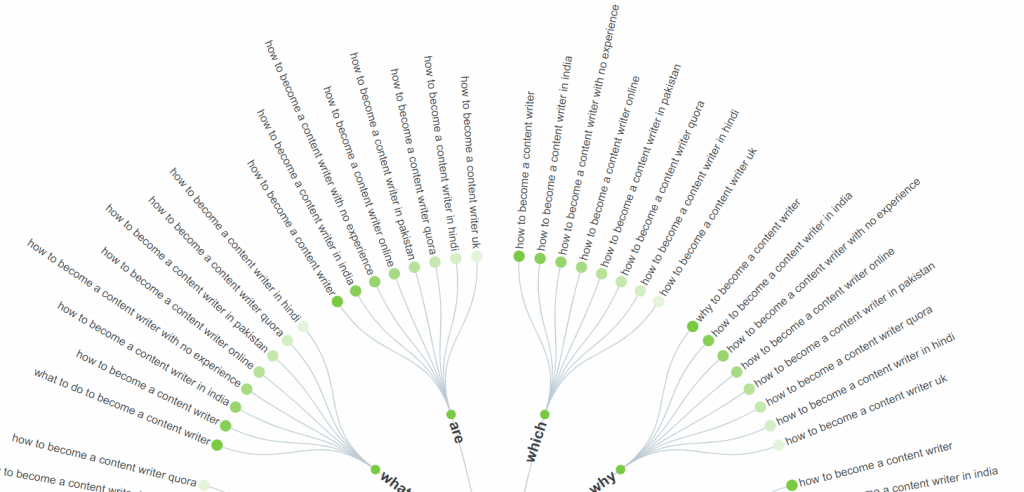
The best part of this online tool is that you can download your result as a .csv file which helps you to track the keywords.
I am sure you’ll get lots of keywords which you haven’t covered yet.
Again, try to add these questions to your subheadings.
After that add all of these additional questions to your Google sheet under the last column.

This is how I have done, even though I covered only a few keywords, it covers many important aspects of becoming a content writer.
Step 7: Keyword revealer
Check out Keyword Revealer.
Now, this is a completely optional step for the people who don’t have access to keyword revealer tool.
In case I have access so I am showing how I enriched my keyword list by using the Keyword revealer tool. Just like other tools, after typing my primary keyword, I get lots of keywords.

But the fact is that most of the keyword, I already covered in the above steps. This is why I am considering this as an optional.
By using this tool, you can also get to know the monthly search volume as well.
Overall, your current goal is to fill Google sheets with only relevant and high-value keywords.
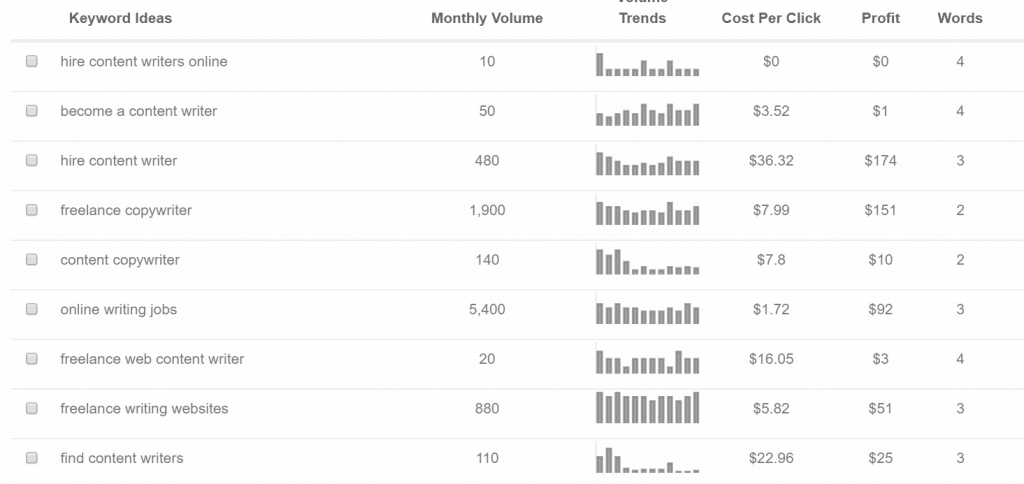
Here is the final list that I got for my target keyword, how to become a content writer.

*Bonus Tips for optimizing your content
Most of the newbie bloggers and content marketers make mistakes of creating content by just focusing on one keyword.
In 2020, writing engaging content by just thinking around one single topic is not aa smart choice. Instead, go for finding a topic, a super-specific topic.
Instead of covering a huge topic in brief, try to write in-depth content on a super-specific niche or topic.
And obviously follow this ultimate guide to find related topics and questions. Because that will help you not to miss any single relevant point regarding your topic.
Not only this, but the entire process will also help your ranking, as it is easier for Google to understand the information on your page.
One of the most essential thing that you need to consider in 2020 while writing content is that stop chasing keywords, instead, try to cover any micro topic in depth.
Google has focused on more in-depth content and as a result, this update will try to rank the pages which have covered all of the subtopics around the specific topic.
The entire process which I have shown you in this article is to get a proper structure so that every question or subtopic gets covered in your final content.
Here are some handpicked articles for you:
Final thought
Find a specific topic⇢ Collect all of the relevant keywords and questions by following this ultimate guide⇢ Structure your content with the keywords⇢ Write it.
Keyword optimization has evolved much from the past few years and it is going to be as well. The only thing that is constant is the quality of the content.
Again, the definition of quality content is also different from what it used to be 10 years back.
Nowadays, the primary goal of creating content should be to help readers to solve all of the queries and doubt regarding the topic.
Since there are other parameters as well in the quality content, using keywords smartly can play a huge role in ranking as well.
The ultimate goal of this content was to help you optimize your content
And I hope you learned something.
If you find it valuable, then please share it. This will motivate me.
Read More, Learn More…
- 10 Free Content Marketing Tools (Tested)
- Blog UX Design Checklist
- 7 Must-Have AI Content Marketing Tools [2025]
- 7 social proof tips to skyrocket your landing page conversion
- I have started Accrue SERP- an SEO company

Sk Rafiqul Islam is a content marketing practitioner with 3+ years of practical experience. He spends most of his time helping businesses to build a loyal audience with content marketing. He is also running a tech career blog called 10Pie and content marketing VIP, a bi-weekly marketing newsletter. In his free time, he loves reading books and playing football.



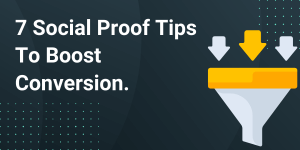
Pingback: Why should you start blogging in 2020? [A statistical Study] » I am Rafiqul
Pingback: 17 Most Essential Tips to Create High-Quality Content » I am Rafiqul
Pingback: 99 super easy tips for beginner bloggers to try - Blogging
Pingback: 5 Best Ways to discover the right content format for your business » I am Rafiqul